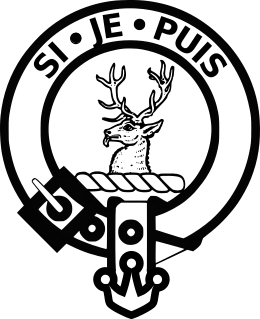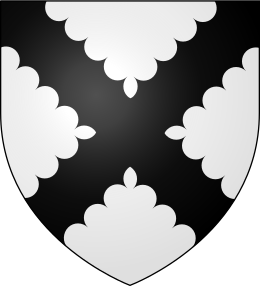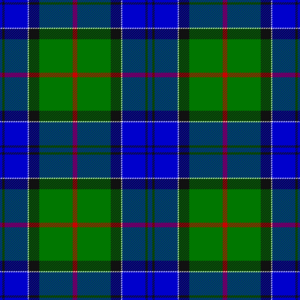Clan Colquhoun facts for kids
Quick facts for kids Clan Colquhoun |
|||
|---|---|---|---|
| Clann a' Chombaich | |||

Crest: A hart's head couped Gules, attired Argent.
|
|||
| Motto | Si je puis. (Engl. If I can) | ||
| War cry | Cnoc Ealachain! (Engl. Hill of the Black Willow) | ||
| Profile | |||
| Region | Highlands | ||
| District | Dunbartonshire | ||
| Plant badge | Hazel saplings. | ||
| Pipe music | The Colquhoun's March | ||
| Chief | |||
 |
|||
| Sir Malcolm Colquhoun of Luss, | |||
| 8th Baronet and Chief of Clan Colquhoun. | |||
| Seat | Rossdhu House. | ||
| Historic seat | Dunglass Castle | ||
|
|||
|
|||
Clan Colquhoun (Scottish Gaelic: Clann a' Chombaich) is a historic Scottish clan from the Scottish Highlands. Clans are like big families or groups of people who share a common ancestor and a strong sense of belonging. The Colquhoun clan has a long and interesting history, full of brave chiefs and important events.
Contents
Discovering Clan Colquhoun
Where the Clan Began
The lands of Clan Colquhoun are found near the beautiful Loch Lomond in Scotland. This area is known for its stunning scenery. The clan's first home was at Dunglass Castle. This castle was built on a rocky point next to the River Clyde. It was also close to the important royal Dumbarton Castle. Later, some Colquhoun chiefs became governors of Dumbarton Castle.
The main title for the clan chief became the Barony of Luss. This happened around 1368. Sir Robert of Colquhoun married the daughter of the Lord of Luss, bringing these lands into the clan.
Important Moments in Clan History
Early Chiefs and Royal Connections
In the 1400s, during the time of young James II of Scotland, Sir John Colquhoun was a very important person. He was put in charge of the royal Dumbarton Castle. Sadly, he was killed during an attack in 1439.
His son, also named Sir John, became a high-ranking official in the king's household. In 1457, he received a special document that made all his lands part of the free Barony of Luss. A year later, he also gained control of the forests of Rossdhu and Glenmachome.
Sir John Colquhoun was also involved in important talks with Edward IV of England in 1474. These talks were about arranging a marriage between Edward's daughter and the young James IV of Scotland. Sir John was later killed by a cannonball while fighting at the siege of Dunbar Castle.
The Colquhoun clan also owned Camstradden Castle. This castle was acquired by a younger son of the Luss family in 1395. One of the Colquhoun Lairds of Camstradden was a famous knight. He fought bravely at the Battle of Pinkie Cleugh in 1547.
Challenges and Changes
The Colquhoun lands were often attacked because of their important location. In 1603, a large group of MacGregor clansmen marched into Colquhoun territory. The chief of Clan Colquhoun had permission from the king to stop the MacGregors.
He gathered a force of soldiers and went to Glen Fruin to fight the raiders. The MacGregors split their group, and while the main forces fought, a second MacGregor group attacked from behind. The Colquhouns were pushed into a difficult area where their cavalry (soldiers on horseback) could not help. More than two hundred Colquhoun men were killed. Many years later, the chiefs of both clans met at the battle site and shook hands, showing peace.
In 1625, Sir John Colquhoun of Luss was given the special title of baronet. This was a new honor from the king. However, in 1632, he faced serious accusations and did not return to answer them. Because of this, his lands were taken away. Luckily, Sir John's oldest son was able to get the family lands back in 1646.
The 1700s and Beyond
In 1703, Sir Humphrey Colquhoun, who was the fifth Baronet, represented Dunbartonshire in the Scottish Parliament. He was strongly against the Treaty of Union, which joined Scotland and England. He did not have any sons, so his title passed to his daughter's husband, James Grant.
Later, James Grant's older brother died, and James took back the name Grant. He was an ancestor of the Earls of Seafield. The Colquhoun estate then went to Sir James Grant Colquhoun. He built the large house called Rossdhu, which is still the home of the Colquhoun chiefs today.
The Colquhoun Chiefs Today
Sir Ivar Colquhoun became the chief of the clan in 1948. He was the 30th Laird of Luss and the 32nd Chief of Colquhoun. He served as chief for almost 60 years, which is a very long time! He passed away in 2008. His son, Malcolm, then became the new chief.
Sir Malcolm is married to Katharine, Lady Colquhoun. His son, Patrick Colquhoun, is next in line to be chief. Sir Malcolm is in charge of the Luss Estates, which are the clan's lands. In 2012, they opened the Loch Lomond Arms Hotel in Luss.
Clan Septs
A "sept" is a family name that is considered part of a larger clan. The Clan Colquhoun International Society recognizes several names as septs of Clan Colquhoun. However, it's interesting to know that some of these names are also claimed by other clans. For example, some names are also linked to Clan Gregor, who were once rivals of Clan Colquhoun.
Some of the names considered septs of Clan Colquhoun include:
- Calhoun, Cahoon, Cahoone, Cohoon, Colhoun
- Cowan, Cowen, Cowing
- Ingram (or Ingraham)
- Kilpatrick, King, Kirkpatrick
- Laing (or Lang)
- McCowan, McMains (or McMain), McManus, McClintock
- McOwan, Covian, McCovian
See also
- Cahoon, a variant name
- Colhoun (disambiguation), a variant name
- Colquhoun, A surname of Clan Colquhoun


